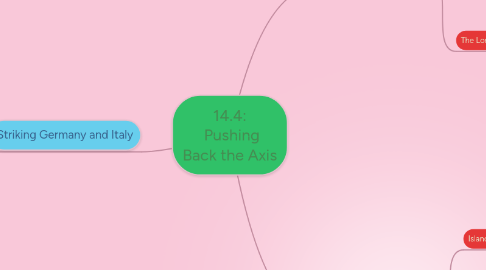
1. Striking Germany and Italy
1.1. Striking the Soft Underbelly
1.1.1. The invasion began on July 10, 1943.
1.1.2. Bombing against Germany
1.1.3. The King of Italy arrested Mussolini
1.1.4. Italy surrendered
1.2. Strategic Bombing
1.2.1. Casablanca Conference. Britain’s Royal Air Force had dropped an average of 2,300 tons (2,093 t) of explosives on Germany every month for more than three years.
1.2.2. The bombing campaign did not destroy Germany’s economy or undermine German morale, but it did cause a severe oil shortage and wrecked the railroad system.
1.2.3. Destroyed so many aircraft factories that Germany’s air force could not replace its losses.
1.3. The Tehran Conference
1.3.1. Roosevelt wanted to meet with Stalin before the Allies invaded France.
1.3.2. Stalin agreed and proposed that Roosevelt and Churchill meet in Tehran, Iran.
1.3.3. France in 1944. Roosevelt and Stalin then agreed to divide Germany after the war so that it would never again threaten world peace.
1.3.4. He also accepted Roosevelt’s proposal of an international peace-keeping organization after the war.
1.3.5. After the conference in Tehran, Roosevelt headed to Cairo, Egypt, where he and Churchill continued planning the invasion of France.
2. Landing in France
2.1. Planning Operation Overload
2.1.1. The allies had the advantage of surprise
2.1.2. By the spring of 1944, more than 1.5 million American soldiers, 12,000 airplanes, and 5 million tons of equipment had been sent to England.
2.1.3. Planned to attack at night, ships arriving at low tide, and the weather must be good for paratroopers to be dropped behind enemy lines,
2.1.4. D-Day June 6th 1944
2.2. The Longest Day
2.2.1. Nearly 7,000 ships carrying more than 100,000 soldiers headed for Normandy’s coast.
2.2.2. 23,000 paratroopers were dropped inland, east and west of the beaches.
2.2.3. well. The German defenses were weak, and in less than three hours the troops had captured the beach and moved inland, suffering fewer than 200 casualties.
2.2.4. Omaha Beach - Under intense German fire, the American assault almost disintegrated.
3. Driving Japan Back
3.1. Island-Hopping in the Pacific
3.1.1. Many of the islands were coral reef atolls and as some 5,000 United States Marines learned at Tarawa Atoll, wading ashore could cause very high casualties.
3.1.2. The "Alligator," or amphtrac
3.1.2.1. was first invented in the late 1930s to rescue people in Florida swamps.
3.1.2.2. If more had been available at Tarawa, American casualties probably would have been much lower
3.1.2.3. Amphtracs were used much more often in future assaults
3.1.3. More than 1,000 marines died on Tarawa
3.2. McArthur Returns
3.2.1. Across the central Pacific, General Douglas MacArthur’s troops began their own campaign in the southwest Pacific.
3.2.2. In the southwest Pacific. The campaign began by invading Guadalcanal in the Solomon Islands, east of New Guinea, in August 1942.
3.2.3. August 1945 when word came that Japan had surrendered.

